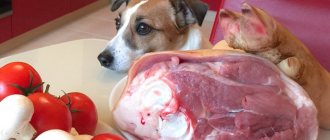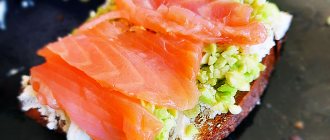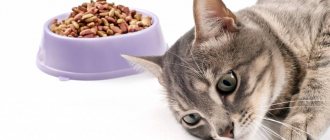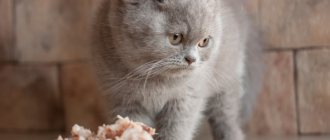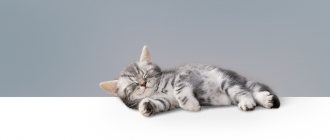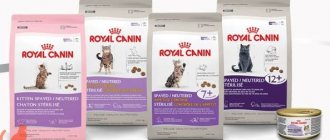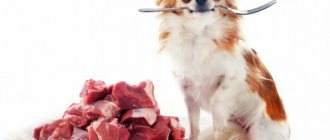A natural diet is preferable for cats than dry or wet ready-made food. But such nutrition must be approached responsibly, since, contrary to popular belief, it will require more time and money. Of course, pets cannot be fed from the table. But, moreover, they should not be given completely raw meat, offal, or eggs. This can lead to health problems. We will tell you what to do with natural products in this article.
Types of “safe” meat for cats
More than 80% of a cat's daily diet is meat. But, before feeding your mustachioed pet this product, you need to figure out which types of meat will be beneficial for the cat’s health and which types of this product can cause serious harm to the body.
First of all, you should focus on the following rules:
- the meat must be fresh;
- low-fat;
- without small and dangerous bones;
- no unpleasant odor.
You need to feed your cat high-quality meat, and not waste product that is not useful on the human table. From time to time, your pet can be pampered with offal and cartilage, always fresh and low-fat (no more than 200g per week).
To feed your cat, you can buy chicken, quail, lean lamb, beef, rabbit, turkey, horse, goat and beef.
Pork, duck, goose and fatty lamb are prohibited.
Now let's figure out in what form meat can be served to a domestic cat.
Grilled meat
Fried product is strictly prohibited for feeding domestic cats. After eating such meat, the animal may experience serious problems with the liver, stomach and other organs of the digestive tract. All this will lead to a lot of unpleasant health problems for the pet and will significantly shorten its lifespan.
Cooked meat
This meat can be given to a cat. It contains many nutrients that are beneficial for her body. The main thing is to cook the meat correctly: boil it in low-fat broth without salt and other spices.
And one more rule: you cannot give raw and cooked meat at the same time. To digest these foods, the body will need to produce different enzymes, which will negatively affect the digestion process. This may manifest itself as vomiting, stool disturbances and other unfavorable symptoms.
Blood for cats
Mostly meat is sold already bled. Of course, some remains, but this is not enough. During the life of the victim, 56% of all blood circulated in its vessels, some was deposited in the liver and spleen, and only 10% was contained in the subcutaneous tissue. When the victim was killed, almost all the blood was drained from him, but it remained in the liver and spleen, as well as in the heart. Therefore, these products serve as a source of blood for the cat.
Blood is a valuable product. It contains that small dose of salt (NaCl) that tailed animals still require. There is a myth that cats do not need salt at all. Needed. Just the amount contained in the products is enough for them. Salt is important for maintaining many vital processes in the body. Therefore, do not pour out or express the drops of blood that remain in the meat after bleeding, but freeze it along with the meat, and after defrosting, carefully pour it into the cat’s bowl.
If you have the opportunity to purchase high-quality blood separately, do not refuse. It also needs to be frozen first if you purchased liquid blood. This is easy to do using ice cube trays. Then take out one cube at a time and add it, defrosted, to the mix. Calculation: 80 ml of blood per 1 kg of meat.
There is also dried blood on sale (so-called blood meal), which can be added to food in pinches. But there is no particular meaning in it, because... it contains proteins that have already been denatured under the influence of high temperatures. On the one hand, the proteins of such blood themselves are absorbed well, however, apart from the protein itself, they do not bring anything useful to the body.
Mixed nutrition
There are three types of diet for domestic cats:
- natural nutrition from ordinary products familiar to humans;
- feeding with ready-made industrial feed created for animals;
- mixed diet, which involves feeding cats natural products in combination with ready-made food.
Natural food and raw meat
When feeding natural food, the issue with raw meat is resolved on its own. This product is included in the pet menu. It can be served in processed form. To get a more nutritious meal, veterinarians recommend combining meat pieces with other healthy foods.
Dry, wet food and raw meat
Is it necessary to feed a cat raw meat if it regularly eats ready-made industrial food?
Restrictions when feeding natural food
Accustoming to the diet begins several months later, as soon as the cat stops feeding milk. When introducing a new product, you need to carefully monitor the reaction. The focus is on the signs of allergies. At the first symptoms, the menu is adjusted. It is quite possible that the situation will change with age, so it is sometimes worth returning to a previously rejected option. The question of whether fresh raw meat can be given to cats is not even discussed; this is an essential component for the harmonious development and formation of a healthy animal. The good thing about natural nutrition is that the same microelement can be found in different foods, so you can create countless combinations of your weekly diet.
What pathologies does raw meat contain?
The biggest risk to a cat from raw meat is the possibility of helminth infection. These parasites not only significantly worsen the general condition of the animal, but can also cause death.
To protect your cat from such risks, properly prepare fresh meat for feeding your pet! Buy this product only from trusted places, carefully checking it for freshness.
Be sure to freeze the meat before serving and heat treat it. For preventative purposes, periodically give your pet anti-helminth medications. An experienced veterinarian will tell you which drug is best to choose.
Raw or cooked
Fresh meat is better digestible and retains nutritional components. Boiled is safer, cats often eat it more willingly, but the taurine and vitamins are partially washed out.
Both types are allowed if prepared correctly:
- Do not serve raw without first freezing.
- When cooking, add a minimum of water or simmer in its own juice.
- Freeze the liver, chop it and scald it with boiling water.
- Do not combine fresh and cooked food in one feeding; different enzymes are required for absorption.
Meat is the main food of a cat's diet, but not all types are suitable for feeding a cat; it becomes useful only after processing.
Meat for castrated and sterilized
As you know, it is very important for cats after sterilization and cats after castration to choose the right diet for feeding. After such operations, great changes occur in the animal’s body, metabolic processes slow down. With improper feeding, there is a high probability of developing certain diseases that significantly worsen the general condition of domestic cats.
After sterilization, cats can be given lean meat, but only in raw and frozen form! The boiled product is not particularly beneficial for the body of operated animals. In addition, boiled meat can provoke protein intoxication, a very dangerous condition for cats.
Portions must be dosed and served fresh. You can also add some types of offal in small quantities to the menu.
After castration, cats can also eat raw lean meat after preliminary freezing. Fractional meals in small portions are encouraged, up to 5-6 times a day.
The cat should not be given a supplement, even if he really asks for it. The restless appetite of a castrated animal often leads to obesity, as a result of which the cat develops other unpleasant health problems.
Is it possible to feed a cat minced meat?
This is not advisable. The concentration of gastric juice in cats is high: the juice processes the minced meat very quickly - and the product slips through the stomach, as a result of which the beneficial substances do not have time to be absorbed as well as when swallowing pieces. In addition, eating pieces requires effort and time, which allows you to feel full by the end of the meal, while cats may not get enough of pates and ask for more. In addition, jaw work is extremely useful both physiologically and psychologically: it triggers a chain of neuroreactions that promote the development of mental abilities and improve mood - do not deny your cat this pleasure.
Minced meats and pates are served only to cats that have no teeth or are unable to digest pieces (these are sick cats who have appropriate recommendations from a veterinarian). Healthy cats consume meat either in small pieces or large whole pieces. In the second case, they use their teeth to tear off smaller parts from a large piece that are convenient for swallowing.
Is it possible to give raw meat to small kittens?
It is possible and even necessary to feed a small kitten raw meat! This product is especially useful not only for the body of a maturing predator, but also for its milk teeth. The first meat food can be introduced into the cat’s diet starting from 2 months of life.
For greater benefit, it is recommended to give the meat to the kitten with a bone, in the process of gnawing which, beneficial massaging of the gums and teeth occurs. Such prevention reduces the likelihood of developing tartar in animals.
The bones should not be small in size. It is unacceptable to give your kitten chicken and fish bones. They are dangerous for animals, as they can injure the esophagus and other organs of the digestive tract.
Also, you should not give your cat boiled bones, which are softer in structure. This product can also cause gastrointestinal problems.
What kind of meat can you feed a kitten? Fresh, low-fat and processed! This product is best served in small pieces. To complete your diet, mix meat with healthy cereals and vegetable purees.
What is important to know when creating a cat menu?
Everyone knows that a cat is a predator. The body of predators is designed so that they can eat raw meat. Cats living in rural areas are great at getting their own food in the summer. Their diet includes mice, lizards, frogs and small birds. They eat mice and lizards without a trace, including the bones, and only feathers remain from birds.
The cat’s digestive system is fully adapted to this:
- sharp teeth and strong jaws allow you to tear off pieces of prey;
- the esophagus is very elastic and easily stretchable, which allows you to swallow large pieces;
- it secretes a sufficient amount of mucus, which helps fairly large pieces of food easily move into the stomach;
- Pepsins are produced in the stomach - enzymes that are necessary for the digestion of proteins. Pepsins break down proteins, and stomach acid digests them;
- The cat's body completely assimilates only protein foods. The cat family almost does not produce the enzymes necessary for processing dairy or plant foods.
In a domestic kitten born in captivity and in a cat that always lives in an apartment, the functioning of the gastrointestinal tract still remains unchanged and does not get used to other food. The gastrointestinal tract cannot adapt and produce other enzymes. If your pet is fed the wrong food instead of meat, it will not be hungry. But he will not receive all the vitamins and microelements necessary for the full functioning of all organs.
It is important to realize that cats are carnivores; their main food is meat.
How often to feed meat, and in what quantity?
Meat is the most important product in the diet of a domestic carnivore. It must be given to the cat every day. According to generally accepted standards, 80-90% of a pet’s daily diet is meat.
The amount of product to feed is calculated individually, depending on the age of the cat and its activity.
On average, kittens need 30g of meat per day, adults – about 100g. If the cat is overly active and spends a lot of time playing outdoor games, you can slightly increase the dosage of this product.
But, in order not to harm your pet’s health, we still recommend that you first consult with a veterinarian, who can accurately determine the norm for feeding your cat with meat products, taking into account its age, weight and activity level.
And remember, proper feeding is the key to a long and happy life for a domestic cat in your friendly family!
Benefits of Eating Raw Food
Increased water consumption
Raw food is closest to a cat's natural diet. Modern cats are descended from carnivores that obtained most of their fluids from their prey. On average, 70% water could be obtained, while only 10% could be obtained from dry food. Cats do not always compensate for the imbalance by drinking large amounts of water, which can lead to urine concentration and crystal formation. Males are especially vulnerable because they have a narrower urethra, the passage that carries urine from the bladder out of the body. The narrow urethra of males is easily blocked by crystals or stones, making urination difficult or impossible. This condition is life-threatening and requires urgent veterinary attention.
Improving dental hygiene
Chewing raw meat removes plaque from your teeth. If not removed regularly, plaque hardens into tartar and leads to gum disease.
Weight maintenance
Dry food is rich in carbohydrates; they are stored as fat. Cats need a diet rich in protein, not carbohydrates. Obesity is a growing problem, with 50% of cats in Australia, the UK and the US being overweight, which carries significant health risks.
High taste characteristics
Not all, but a large number of cats prefer the taste and texture of raw food rather than dry or canned food.
Key points
If you are considering transitioning your cat to an all-raw food diet, do your research first. If you want to do it right, you have a lot to learn about cat nutrition. The purpose of this article was to discuss how to properly introduce raw meat into the diet several times a week, but not how to completely transition a cat to a raw diet. There are several benefits to switching to a raw diet, but remember, if you do it wrong, your pet can get very sick.
Many people have switched to raw food only; others prefer a mixed version of raw meat, canned food and dry food. This is a good option because, for example, chewing muscles is good for the teeth, but not nutritious enough, so it is recommended to combine raw meat with dry food.
Based on materials from: www.cat-world.com
How to secure meat before feeding
To destroy bacteria and parasites, it is necessary to freeze the meat before feeding the cat.
Some parasites and bacteria contained in meat products of animals and birds can be killed by freezing above 20 degrees from 24 hours to one week. Also by boiling meat. However, some nutrients disappear during cooking, for example, taurine, which is necessary for the health of the animal.
It is important to monitor the quality of meat products and their expiration dates. Do not allow your pet to feed leftovers, scraps or spoiled meat.
It was better to purchase meat from local livestock and chicken breeders.
It is necessary to store meat used to feed a cat at a temperature no higher than 5ﹾC and serve the animal the amount that it will consume at one time, so that the leftovers do not spoil.
Why is the raw product dangerous?
Pets often become infected with salmonella through this product.
If you give your cat raw meat alone, the following problems may occur:
- Infection with helminths. These are roundworms, toxocara, flukes, trichinella, which cause serious organ dysfunction, even death.
- Hyperparathyroidism. Characterized by deformation and fracture of bones, neurological disorders.
- Bacterial infections. Often diagnosed are salmonellosis or colibacillosis, accompanied by diarrhea and general intoxication.
Natural food or ready-made food
It may seem like why spend time and extra effort to prepare food for cats. After all, there is a huge line of ready-made animal food on sale, from the economy series to the premium class. But how healthy is this food for your pet?
Common inexpensive cat foods contain virtually no ingredients stated on the label. At best, the composition includes meat by-products and soy, which is absolutely not enough for the needs of the animal. But they contain a lot of preservatives and flavorings, which give the food an aroma and taste that is attractive to cats.
Experts do not recommend feeding animals such food for a long time or at least supplementing it with vitamins and mineral supplements.
In feeds of a higher price segment, the content of natural products is much higher. In addition, they already contain vitamins necessary for the animal, and they contain beneficial vitamin E as a preservative. Such food is not only healthy, but also tasty for your pet.
An alternative to these foods can be natural food. Just remember that feeding a cat and eating from the owners’ table are completely different things.
Prohibited species
There are certain types of meat that should not be given to a cat, even if the product is very good and high quality. This is especially important for pets living in comfortable conditions, since their metabolic processes have already been rebuilt.
First of all, cats are not given pork or any other fatty varieties. These include duck and goose. Even a small amount of pork provokes the development of obesity in a cat. For the same reason, it is forbidden to feed minced meat: it contains a huge amount of fat, which is harmful to the animal.
You should not give meat from an old cow, chicken, etc. Its taste and nutritional qualities deteriorate excessively, and such a diet can make the animal sick. Carrion is also prohibited, because it is a source of pathogenic microflora and serious diseases.
It is forbidden to feed a cat bones. They are not digested in the stomach. Large amounts of bone cause intestinal obstruction. In addition, sharp fragments can injure the stomach and intestines, as a result of which the animal dies after a few hours from bleeding into the abdominal cavity.
You should not give your pet sinews or other inedible waste. After all, these products must be chewed thoroughly, and cats are accustomed to swallowing pieces. This could cause the cat to strangle itself. And if the veins get into the stomach, they irritate the walls of the organs, causing diarrhea and vomiting.
The dangers of raw meat products
Unprocessed meat is quite often infected with worms, and they, accordingly, lead to a significant deterioration in the health of the pet. And if the worms are not eliminated with the help of anthelmintics, the disease can cause severe intoxication. Without urgent treatment, acute poisoning ends in the death of the pet.
It is especially dangerous to buy meat with by-products at spontaneous markets. In such places, products, as a rule, do not undergo sanitary control, which is why they may be infected with helminths. In some laboratories, worms are not detected due to the fact that the infection occurred several days or hours before slaughter, and the presence of dangerous parasites was not determined.
The risks of bacterial and helminthic infection are also high in the meat of river fish. It is strictly forbidden to give it to cats. Sometimes even a small piece of fish led to severe parasitic poisoning and even death.
What role does it play in a cat's diet?
Everyone knows that cats are predators. Therefore, raw meat for these animals is a natural and main component of the diet. The share of this product in the daily cat menu can reach up to 80%. Regular consumption of meat provides the cat with the necessary proteins and amino acids, which play a key role in the formation of the bone skeleton and muscle tissue.
Is it worth feeding a cat raw meat? Many owners are interested in it.
Their deficiency, especially taurine, can cause serious health problems and can lead to:
- blindness;
- deterioration of wool quality;
- baldness;
- heart failure;
- disruption of the normal functioning of the endocrine system.
For your information! Some breeders try to compensate for taurine deficiency by including foods rich in plant protein in the cat's diet. However, it should be noted that in protein foods of plant origin there is either no taurine at all, or it is found in negligible quantities.
